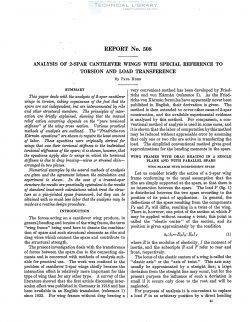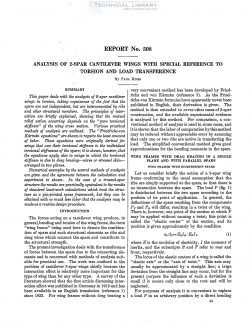naca-report-508

- Version
- 201 Downloads
- 2.00 MB File Size
- 1 File Count
- August 30, 2016 Create Date
- August 30, 2016 Last Updated
National Advisory Committee for Aeronautics, Report - Analysis of 2-Spar Cantilever Wings with Special Reference to Torsion and Load Transference

This paper deals with the analysis of B-spar cantilever
wings in torsion, taking cognizance of the fact that the
spars are not independent, but are interconnected by ribs
and other structural members. The principles of inter-
action are briefly eaplained, showing that the mutual
relief action occurring depends on the “pure torsional
stiflness” of the wing cross section. Various practical
methods of analysis are outlined. The “Friedrichs-von
Kdrmdn equations” are shown to require the least amount
of labor. These equations were originally derived for
wings that owe their torsional stifiness to the individual
torsional stifinesses of the spars; itis shown, however, that
the equations apply also to wings in which the torsional
stifl'ness is due to drag bracing—wires or stressed slain—
arranged in two planes.
Numerical examples by the several methods of analysis
are given and the agreement between the calculation and
experiment is shown. In the case of a trussed—spar
structure the results are practically equivalent to the results
of standard least-work calculations which treat the struc-
ture as a pin-jointed space framework, but they can be
obtained with so much less labor that the analysis may be
made as a routine design procedure.
The forces acting 'on a cantilever wing produce, in
general, bending and torsion of the wing frame, the term
”wing frame” being used here to denote the combina—
tion of spars and such structural elements as ribs and
drag wires which connect the spars and contribute to
the structural strength.
The present investigation deals with the transference
of forces between the spars due to the connecting ele-
ments and is concerned with methods of analysis suit-
able for practical use. The work was confined to the
problem of cantilever 2-spar wings chiefly because the
interaction effect is relatively more important for this
type of wing than for any other type. A survey of the
literature showed that the first article discussing inter-
action effect was published in Germany in 1918 and has
been available in an English translation (reference 1)
since 1923.
| File | Action |
|---|---|
| naca-report-508 Analysis of 2-Spar Cantilever Wings with Special Reference to Torsion and Load Transference.pdf | Download |
Comment On This Post